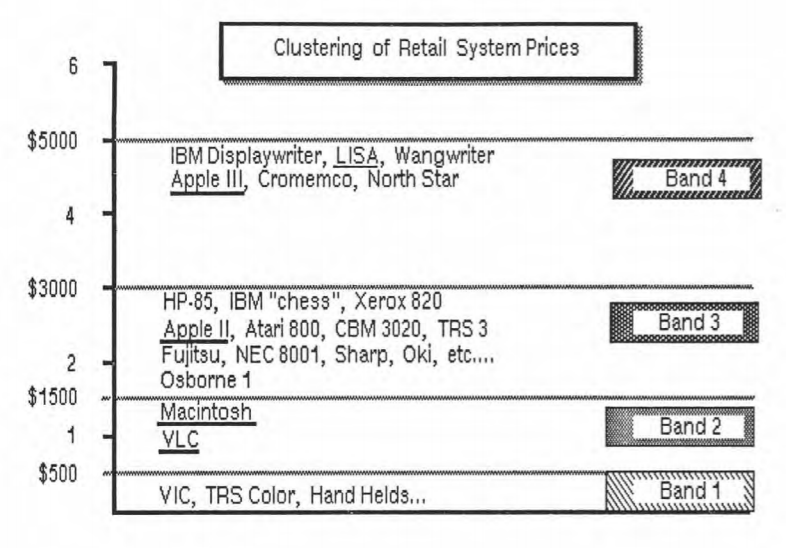Need a Business Plan Template? Here Is Apple's 1981 Plan for the Mac. If you want to write a business plan, Apple's plans for the Macintosh can help.

Business plans are often composed of four parts. There is typically an executive summary, a marketing plan, a management team description and a breakdown of company finances. When Apple's Joanna Hoffman created the preliminary business plan for the original Macintosh in 1981 (available in full here), she added one more part: open issues.
If you're looking for a business plan template you can use to outline your product or service, you probably can't find a better business to emulate than Apple. Here is a breakdown of what Apple covered in its 29-page document.
Related: How to Create a Marketing Plan
1. Apple Product Overview
The point of an executive summary is to succinctly describe a large amount of material without making people read too much. The quicker you can get others to understand your offering's value, the better off you'll be. Hoffman summarizes the Mac's unique value with just four charts and two paragraphs.
The Mac's premise was simple -- most companies sold computers in four price brackets:
- $500 or less
- $501 to $1,500
- $1,500 to $3,000
- $3,000 to $5,000 (or more)
However, the first two brackets were reserved for handheld or low-performing devices. With the Macintosh, Apple planned to create a computer in the second bracket while still maintaining high-quality hardware and software.

Here's what Hoffman wrote in the Mac's executive summary: "I currently know of no products being developed by competition for Band 2 (unfortunately this doesn't mean there arn't [sic] any!). One would expect serious business customers will move up to Band 4 and the job of Macintosh and VLC is to migrate the remaining Band 3 customers to Band 2, leaving Band 3 manufacturers out in the cold!!"
In other words, Hoffman was unaware of any high-functioning computers being sold in the second price bracket -- from $500 to $1,500 -- where Apple planned to position its Macintosh. Most brands sold computers instead for somewhere between $1,500 and $3,000, which Apple considered the third bracket. Its plan was to create an accessible, affordable computer for less than $1,500 (the Mac) and an ultra-powerful option for more than $3,000 (the LISA).
That way, users had their choice of computers and Apple avoided direct competition with other computers in the same price range.
Related: How to Write a Business Plan
2. Macintosh Markets and Software Ranking
Hoffman opened the second section of the Mac's business plan with a simple, but important, statement: "The advantage of a product line is that each individual product does not have to do everything."
The Macintosh did not need to have identical capabilities to its other offerings, like the powerful-but-expensive LISA, because those who preferred more functionality could simply buy the LISA instead.

That's why Apple played up the Mac's differences in its marketing plans. In mock posters, Apple labeled the Mac as "LISA's little brother."
You can see how Apple chose to emphasize Mac's differences from LISA in the famous 1984 Super Bowl commercial, three years after Apple created its preliminary business plan. In an interview with Bloomberg, Lee Clow (one of the creatives on the ad) explains how the ad was meant to show that computers were finally accessible to everyone, and not just for Big Brother or the elite.
In its business plan, Apple also broke down how the lower cost and accessibility could affect three marketplaces:
- For the office: "Every day, more managers rely on computers to help perform their functions effectively and efficiently. MAC makes it possible for any manager to experience the automated office with minimum investment of time and money. MAC will be a rewarding first computer experience."
- For education: "As Word Processors are replacing typewriters in the real world, students need to learn word processing, not just typing. MAC will help the students of the '80s learn the tools of the '80s and prepare Computer Literate students for colleges and employment."
- For the home: "The family Macintosh facilitates management of personal finances and records, makes it possible to take advantage of convenient services such as home banking and home shopping. MAC also provides Entertainment and Education for every member of the family."
Look at the language in these statements -- you see words like "any" and "every." You see that Apple means to help "the students of the '80s" -- not some students or most, but all of them. In each case, Apple positioned the Mac to be available to more people than ever before.
Related: Outline of a Sample Business Plan
3. Macintosh Organization, Staffing and Budget

Some companies choose to separate the Staffing and Budget sections, but Apple chose to combine them in its Mac business plan. In large part, this is because Apple's staffing decisions affected its budget so heavily.
In July of 1981, when Hoffman wrote and Steve Jobs approved the preliminary Mac business plan, there were 28 employees working on the project. By December, the company estimated there would be 63. As a result, a large portion of the Macintosh operating expenses were tied up in paychecks.
In this section of its business plan, Apple also broke down the cost of making a Macintosh ($397), how much it would cost to distribute the products, and the potential operating profit.

Apple broke down the operating profit for a variety of different price points, from offering the Macintosh for $995 all the way up to its projected price point of $1495. That way, it could understand how much it should sell the Macs for in order to make the maximum profit and stay in the black.
Related: Sample Business Plans
4. Open Issues
Apple's preliminary business plan hadn't solved every potential problem the Macintosh would face. However, in its final section, the company did lay out the major challenges ahead. They were:
- "Europe has not been given much consideration yet."
- "We are designing our packaging to accept a door-less disk drive only. ... Should we be taking this risk?"
- "Who will manufacture Macintosh?"
- "Is our schedule realistic?"
- "How do we get PCS to feel a 'part' of the Macintosh?"
Note the fourth issue in particular. Apple wondered whether its 1982 release date was overly optimistic. Given that the Macintosh was actually released two years later, in 1984, clearly there was cause for concern. But, Apple's business plan allowed for the company to foresee that and react accordingly.
Related: Use These 5 Steps to Create a Marketing Plan
The Apple Macintosh business plan template
Apple's early business plan helped organize its efforts for the Macintosh, and the Macintosh has helped revolutionize the computer industry.
That isn't to say everything went exactly according to plan. The first part of the Macintosh business plan was an overview of the product, or an executive summary. It explained how the Macintosh would be more affordable than any of its competitors. In the second part of the business plan, which explained the company's marketing plans, you can see how Apple planned to market the Macintosh as a computer for the people. This idea was then clearly executed in its 1984 Super Bowl ad.
However, due to the marketing costs, Apple ended up selling the Macintosh for $2,495 -- well over its intended price. The third section of the business plan broke down the company's organization, staffing plans and budget, placing Jobs at the top of the Macintosh's organization chart. However, just a year after the first Macintosh was released, Jobs resigned from Apple and started NeXT.
Those were massive setbacks, but life happens. Apple and Joanna Hoffman knew that when they put together the business plan, and that's why the fourth and final section asked questions that Macintosh needed to address before its launch.
When you're writing your own business plan, you don't have to do everything Apple did. You probably shouldn't, in fact. But, you can use this plan as a template to organize your thoughts. You can even use it as inspiration to admit you don't know everything. Clearly, not even Apple knew the future.









